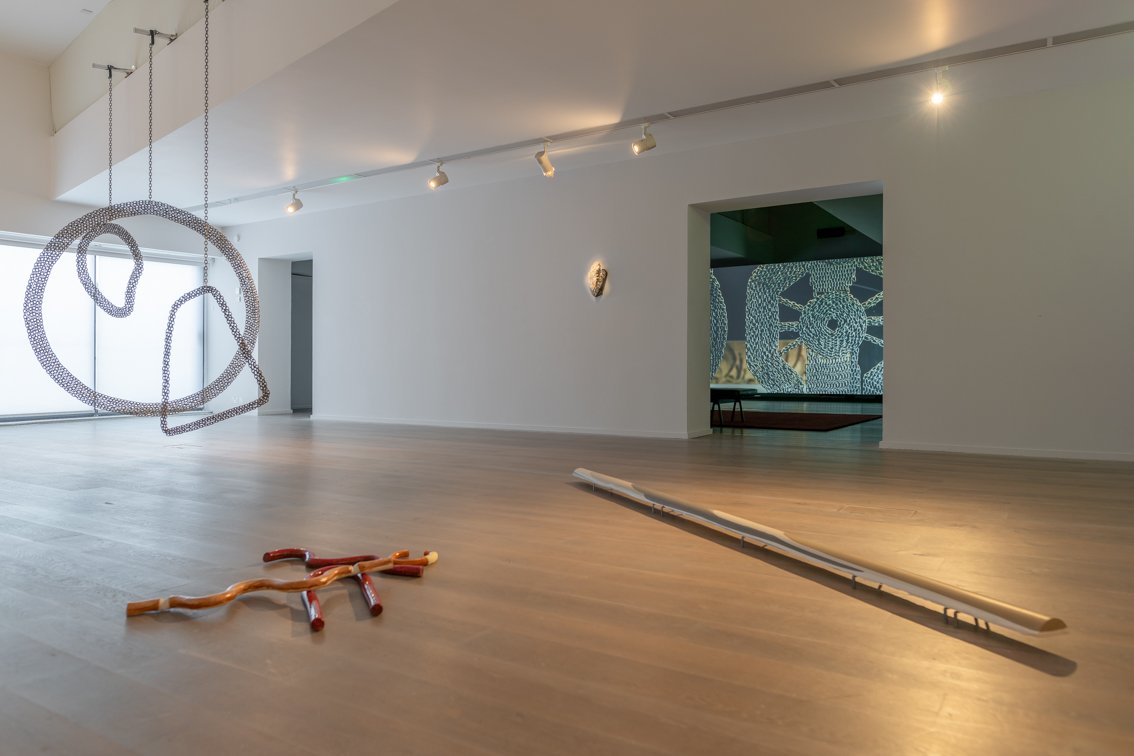GVOZDENE KAPIJE / THE IRON GATES, 2025
Gvozdene Kapije / The Iron Gates, 2025, Film still from single channel film, 46 min







Installation views, Gvozdene Kapije, 2025, Solstice Arts Centre, Ireland. Single channel 46min 4k film, fired stoneware ceramics, welded mild steel chain, cast jesmonite, glazed earthenware, dimensions variable. Photography by Louis Haugh
GVOZDENE KAPIJE / THE IRON GATES
Through the practice of sculpture and film making, Barbara Knežević’s most recent projects explore the politics of origin stories and historical narratives that are fragmented and called into question through individual and personal experiences such as migration, displacement and diaspora and the instrumentalisation of sculptural objects in the narratives of identity and nationhood.Gvozdene Kapije (The Iron Gates)locates Knežević’s diasporic Yugoslav identity explicitly in her work for the first time and places the artist’s family experiences against the backdrop of larger historical narratives of the Danube and the Balkans.
The exhibition features a newly commissioned forty-six-minute film and a series of large-scale sculptures that engage with the Gvozdene Kapije (The Iron Gates) region, a deep scenic gorge on the Danube River on the border of Serbia and Romania. The featured works interpret histories, stories, materiality and technological developments related to the Iron Gates dam, built in 1964 as a collaborative initiative between the governments of the former Yugoslavia and Romania. The sculptures are shown alongside and feature in the film. Knežević describes this project as a ‘sculptural film’, a mode of filmmaking where moving images heighten the sensitivities, histories and material qualities of objects, and where non-human actors have agency and power.
The film focuses on the Mesolithic sculptures of Lepenski Vir, considered some of the first European monumental sculptures, discovered during preparatory work for the construction of the dam. The narrative, voiced in the first person, gives expression to nonhuman, material, infrastructural, animal and geological actors of the Iron Gates gorge. Composed of original footage captured in Donji Milanovac, Kladovo and Belgrade, the film’s personal testimonies, interviews, staged imaginings, choreographies and archival footage oscillate between fact and speculative fiction, using montage as a device to retrace stories of displacement, migration, the culture of making, sculpture and the natural world on the Danube.
The sculptures in the exhibition implement a similar language of monuments and temporality. They are composed of industrial materials that were then processed by the artist’s hand. Welded chain, mesh and steel have been formed and fabricated alongside more intimate, domestic materials such as ceramic, fabric, stone and wood. Weaving historical and speculative chapters, the film and sculptures tell a fragmented, selective trajectory of human origins and development, navigating geopolitical shifts in South Eastern Europe and proposing different notions of progress.
Gvozdene Kapije (The Iron Gates)is commissioned by Solstice Arts Centre, Navan, Co. Meath, with production support provided by the Arts Council of Ireland and the National Sculpture Factory, Cork. Following the presentation at Solstice Arts Centre, the exhibition will travel to Regional Cultural Centre, Letterkenny, Co. Donegal; Sirius Arts Centre, Cobh, Co. Cork; and Wexford Arts Centre, Co. Wexford. The tour is organised by Rayne Booth through specific funding provided by the Arts Council of Ireland.
Tour Schedule:
Solstice Arts Centre: 29 March – 30 May 2025
Sirius Arts Centre: 27 September – 29 November 2025
Wexford Arts Centre: 14 February – 20 March 2026
Regional Cultural Centre: 4 July - 19 September 2026
Film production credits
A film by Barbara Knežević
Producers
Marija Stojnić
Jelena Angelovski
Executive Producer
Barbara Knežević
Director of Photography
Dušan Grubin
Editor
Ivan Vasić
Sound design and Mix
Bojan Palikuća
Original Music Score
Karl Burke
Vladimir Blagojević
Choreographer
Marko Milić
Knezevic Studio Limited in co-production with Bilboke
Commissioned by Belinda Quirke, Solstice Arts Centre
In collaboration with Narodni Muzej u Beogradu, Turistički prostor Lepenski Vir, Hidroelektrana Đerdap
Supported by Arts Council of Ireland, Visual Arts, National Sculpture Factory, Technological University Dublin
Project partners and collaborators
Major funder: Arts Council of Ireland
Funders: Solstice Arts Centre, Navan; National Sculpture Factory, Cork
Exhibition partners: Solstice Arts Centre, Sirius Arts Centre, Regional Cultural Centre, Wexford Arts Centre
Exhibition curator and touring producer: Rayne Booth
Development of touring supporter: Sirius Arts Centre
